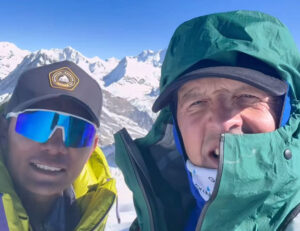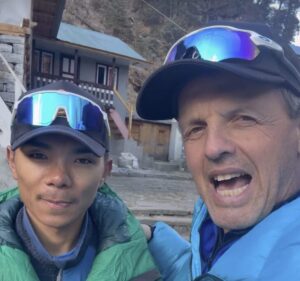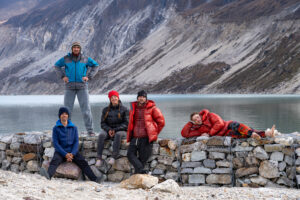Everything is ready for a first summit push on Annapurna after the wind and snow die down. But forecasts show no improvement for the next few days. Climbers always need patience, but with Annapurna, it really can be a matter of life and death.
Haste harms
So far, EliteExped has led the way on the mountain. The team’s Sherpas fixed the route until slightly above Camp 2 last week when the snow began. Their clients managed to spend two days in Camp 2, despite the worsening weather. The climb to Camp 2 and back is the only acclimatization rotation for those using supplementary oxygen.
Meanwhile, climbers from several expedition teams arrived in Base Camp over the last few days. Many of them are already acclimatized after training in hypoxic tents at home or climbing lesser peaks.
This means that once the weather improves, the rope-fixing team will begin advancing again, all the way to the summit, if possible. A number of clients on O2 will follow right behind.
Currently, however, conditions are far from ideal. The forecast predicts snow and very high winds all week. This will increase avalanche risk even after the weather improves.

The forecast by Meteoexploration.com shows snow and high winds on the summit of Annapurna this week.
Hazardous sections ahead
The first task ahead for the rope-fixers will be the route to Camp 3, up the most dangerous section of the mountain. On the way, they will pass beneath a huge, avalanche-prone couloir and through a maze of broken seracs.
Recently, Mingma G analyzed what is possibly the safest way to Camp 3, based on his experiences in 2014, 2015, and 2021. On each occasion, he climbed a slightly different line, as shown in the photo below: 2014 (yellow), 2015 (red), and the original route, which he climbed in 2021 (green). According to his comments posted by Carlos Garranzo on his Alpymon blog, the green line was best.

Different routes to Camp 3 on Annapurna. Mingma G suggests that the green line is often the best route, although conditions vary from year to year. Photo: Mingma G/Facebook
The red arrows show the avalanches that often fall down the couloir, and usually stop at the area signaled with a red circle. The blue lines on the left are also avalanche trajectories from collapsing seracs and the steep terrain.
Mingma G concludes that the safest way to climb Annapurna is to keep on the lower part of the red circle while traversing, then gain altitude among the seracs, to the right of the “blue” avalanche-prone area. Other climbers suggest that the precise line varies each year, depending on conditions.
Nirmal Purja of EliteExped calls the weather “very temperamental”. He left the stormy Base Camp for some days of paragliding away from the mountains.
NW Face team acclimatizing off-site
The only team going for a different route on Annapurna than the normal commercial one will not arrive for some time. Adam Bielecki, Mariusz Hatala, and Felix Berg will acclimatize completely before attempting their new line up the NW Face.
Bielecki and Hatala are currently climbing Ojos del Salado in Chile, while Felix Berg is training in the Alps and using a hypobaric chamber, as he told Stefan Nestler. In April, they’ll meet in Nepal to complete the acclimatization by climbing 7,126m Himlung, a popular 7,000’er. Only then will they head for Annapurna.
Manaslu: Camp 2 reached

Not exactly spring-like weather on Manaslu today. Photo: Adriana Brownlee/Instagram stories
The snowfall seems to be affecting the whole of Nepal. Khoo Swee Chiow of Singapore, also aiming for Annapurna but currently on his way to Mera Peak for acclimatization, reports heavy snow in the Khumbu as well.
Dhaulagiri

Frame of the video in which Allie Pepper of Australia explains her 14x8000er project.
After years of climbing at home in the Blue Mountains and then climbing and guiding in the Andes, Pepper headed for the Himalaya and summited Cho Oyu no-O2 in 2007. In the last few years, she has climbed Everest, Annapurna, and Manaslu’s foresummit (with oxygen). She also attempted Makalu and Lhotse without O2.






